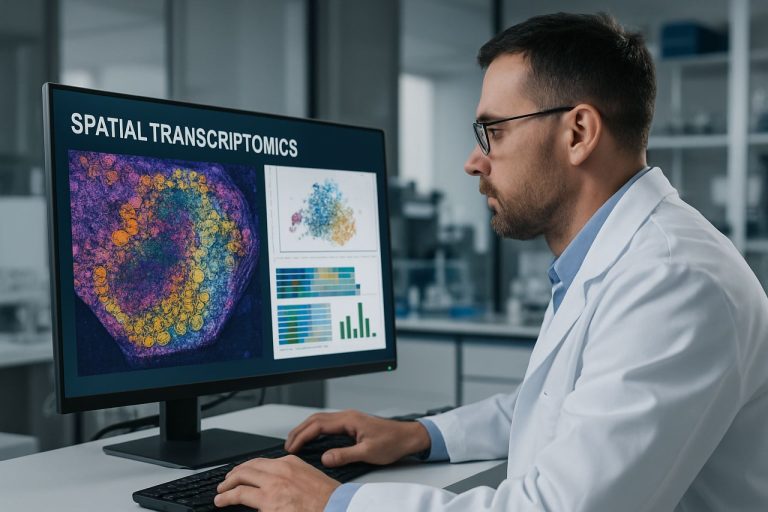
Spatial Transcriptomics Analysis Platforms Market Report 2025: In-Depth Analysis of Growth Drivers, Technology Innovations, and Competitive Dynamics. Explore Key Trends, Forecasts, and Strategic Opportunities Shaping the Industry.
- Executive Summary & Market Overview
- Key Technology Trends in Spatial Transcriptomics Analysis Platforms
- Competitive Landscape and Leading Players
- Market Growth Forecasts and Revenue Projections (2025–2030)
- Regional Market Analysis and Emerging Hotspots
- Future Outlook: Innovations and Strategic Roadmap
- Challenges, Risks, and Opportunities for Stakeholders
- Sources & References
Executive Summary & Market Overview
Spatial transcriptomics analysis platforms represent a transformative segment within the life sciences, enabling researchers to map gene expression within the spatial context of tissues. Unlike traditional bulk or single-cell RNA sequencing, these platforms preserve the spatial information of transcripts, offering unprecedented insights into tissue architecture, cellular interactions, and disease microenvironments. As of 2025, the spatial transcriptomics market is experiencing robust growth, driven by technological advancements, expanding applications in oncology, neuroscience, and immunology, and increasing investment from both public and private sectors.
According to Grand View Research, the global spatial transcriptomics market was valued at approximately USD 250 million in 2023 and is projected to grow at a compound annual growth rate (CAGR) exceeding 15% through 2030. This growth is fueled by the rising adoption of spatially resolved transcriptomic techniques in academic research, drug discovery, and clinical diagnostics. Key players such as 10x Genomics, NanoString Technologies, and Illumina are at the forefront, continually innovating to improve resolution, throughput, and ease of use.
Spatial transcriptomics platforms can be broadly categorized into imaging-based and sequencing-based approaches. Imaging-based methods, such as those offered by NanoString Technologies (GeoMx Digital Spatial Profiler), enable high-plex RNA detection with spatial precision, while sequencing-based platforms, like 10x Genomics Visium, combine spatial barcoding with next-generation sequencing for transcriptome-wide analysis. The integration of advanced bioinformatics tools and artificial intelligence is further enhancing data interpretation, making these platforms more accessible to a wider range of users.
Geographically, North America dominates the market, attributed to strong research infrastructure, significant funding, and early adoption of cutting-edge technologies. However, Asia-Pacific is expected to witness the fastest growth, propelled by increasing investments in genomics and expanding biopharmaceutical industries, particularly in China and Japan (MarketsandMarkets).
In summary, spatial transcriptomics analysis platforms are rapidly reshaping molecular biology and precision medicine. Their ability to provide spatially resolved gene expression data is unlocking new frontiers in understanding complex biological systems and disease mechanisms, positioning the market for sustained expansion through 2025 and beyond.
Key Technology Trends in Spatial Transcriptomics Analysis Platforms
Spatial transcriptomics analysis platforms are rapidly evolving, driven by technological innovations that enhance the resolution, throughput, and interpretability of spatial gene expression data. In 2025, several key technology trends are shaping the competitive landscape and expanding the applications of these platforms.
- High-Resolution Imaging and Multiplexing: Advances in imaging technologies, such as high-definition fluorescence microscopy and in situ sequencing, are enabling single-cell and even subcellular resolution in spatial transcriptomics. Platforms like 10x Genomics and NanoString Technologies are integrating multiplexed detection capabilities, allowing simultaneous analysis of hundreds to thousands of transcripts within a single tissue section.
- Integration of Multi-Omics Data: There is a growing trend toward combining spatial transcriptomics with other omics layers, such as proteomics and epigenomics. Companies like Bruker Corporation are developing platforms that facilitate the co-localization of RNA, protein, and chromatin modifications, providing a more comprehensive view of tissue microenvironments.
- AI-Driven Data Analysis: The complexity and volume of spatial transcriptomics data necessitate advanced computational tools. Artificial intelligence and machine learning algorithms are increasingly being embedded into analysis pipelines to automate cell segmentation, spatial pattern recognition, and biomarker discovery. Illumina and Thermo Fisher Scientific are investing in cloud-based platforms that leverage AI for scalable and reproducible data interpretation.
- Scalability and Automation: Automation of sample preparation, imaging, and data processing is reducing hands-on time and increasing throughput. This is particularly important for clinical and large-cohort studies. Leica Biosystems and Akoya Biosciences are leading efforts to develop fully automated spatial transcriptomics workflows.
- Open-Source and Interoperable Software: The adoption of open-source analysis tools and standardized data formats is facilitating collaboration and data sharing across the research community. Initiatives supported by organizations like the Human Cell Atlas are accelerating the development of interoperable software ecosystems.
These technology trends are collectively driving the adoption of spatial transcriptomics analysis platforms in both research and clinical settings, enabling deeper insights into tissue architecture, disease mechanisms, and therapeutic targets.
Competitive Landscape and Leading Players
The competitive landscape for spatial transcriptomics analysis platforms in 2025 is characterized by rapid innovation, strategic partnerships, and increasing market consolidation. The sector is dominated by a mix of established genomics companies and emerging biotechnology firms, each vying to expand their technological capabilities and market share. Key players are focusing on enhancing spatial resolution, throughput, and data integration to address the growing demand for high-precision tissue mapping in research and clinical applications.
10x Genomics remains a market leader, leveraging its Visium Spatial Gene Expression platform, which is widely adopted for its robust workflow and compatibility with a range of tissue types. The company continues to invest in expanding its product portfolio, including the introduction of higher-resolution assays and integrated software solutions for data analysis. Strategic collaborations with academic institutions and pharmaceutical companies further strengthen its market position.
NanoString Technologies is another prominent player, with its GeoMx Digital Spatial Profiler offering high-plex spatial profiling capabilities. In 2025, NanoString is expected to maintain its competitive edge through continuous innovation, such as the development of next-generation chemistry and expanded panel content. The company’s focus on translational research and clinical adoption is supported by a growing body of peer-reviewed publications and multi-center validation studies.
Emerging companies like Cartana (acquired by 10x Genomics), RareCyte, and Akoya Biosciences are intensifying competition by introducing novel spatial transcriptomics technologies. Akoya’s CODEX platform, for example, integrates spatial proteomics with transcriptomics, appealing to researchers seeking multi-omic insights. These companies are also forming alliances with software developers to streamline data analysis and visualization, addressing a key bottleneck in spatial omics workflows.
Additionally, large sequencing companies such as Illumina are entering the spatial transcriptomics space through partnerships and technology acquisitions, aiming to offer end-to-end solutions from sample preparation to data interpretation. This trend is expected to accelerate as demand for spatially resolved transcriptomic data grows in oncology, neuroscience, and developmental biology.
Overall, the competitive landscape in 2025 is marked by technological convergence, with leading players differentiating themselves through platform versatility, data integration capabilities, and strategic collaborations. The market is poised for further consolidation as established firms acquire innovative startups to broaden their spatial omics portfolios and maintain leadership in this rapidly evolving field.
Market Growth Forecasts and Revenue Projections (2025–2030)
The spatial transcriptomics analysis platforms market is poised for robust growth between 2025 and 2030, driven by accelerating adoption in biomedical research, oncology, and drug discovery. According to projections by Grand View Research, the global spatial transcriptomics market is expected to achieve a compound annual growth rate (CAGR) exceeding 15% during this period, with the platforms segment representing a significant share of this expansion.
Revenue forecasts indicate that the market for spatial transcriptomics analysis platforms will surpass USD 1.5 billion by 2030, up from an estimated USD 600 million in 2025. This surge is attributed to increasing investments in single-cell and spatial genomics, as well as the integration of advanced imaging and sequencing technologies. The growing demand for high-resolution spatial mapping of gene expression in tissue samples is further fueling platform adoption, particularly in academic and clinical research settings.
Key drivers of this growth include:
- Rising prevalence of cancer and neurodegenerative diseases, prompting the need for spatially resolved transcriptomic data to inform precision medicine strategies.
- Technological advancements by leading platform providers such as 10x Genomics and NanoString Technologies, which are continuously enhancing throughput, resolution, and ease of use.
- Expansion of collaborative research initiatives and consortia, such as the Human Cell Atlas, which are accelerating the adoption of spatial transcriptomics platforms globally.
Regionally, North America is projected to maintain its dominance in market share through 2030, supported by substantial funding for genomics research and the presence of major industry players. However, Asia-Pacific is anticipated to exhibit the fastest growth rate, driven by increasing R&D investments and expanding biotechnology infrastructure in countries like China and Japan (MarketsandMarkets).
In summary, the spatial transcriptomics analysis platforms market is set for significant revenue growth from 2025 to 2030, underpinned by technological innovation, expanding research applications, and a favorable funding landscape. Stakeholders can expect heightened competition and rapid platform evolution as the market matures.
Regional Market Analysis and Emerging Hotspots
The global spatial transcriptomics analysis platforms market is experiencing dynamic regional shifts, with North America, Europe, and Asia-Pacific emerging as key growth engines through 2025. North America continues to dominate, driven by robust investments in genomics research, a high concentration of leading biotechnology firms, and strong academic-industry collaborations. The United States, in particular, benefits from significant funding initiatives such as the NIH’s Human BioMolecular Atlas Program (HuBMAP), which accelerates the adoption of spatial transcriptomics technologies in both research and clinical settings. Major platform providers, including 10x Genomics and NanoString Technologies, are headquartered in this region, further consolidating its leadership position.
Europe is rapidly closing the gap, propelled by pan-European research consortia and government-backed precision medicine initiatives. Countries such as Germany, the United Kingdom, and Sweden are at the forefront, leveraging strong public-private partnerships and a growing network of biobanks. The European Union’s Horizon Europe program and national funding bodies are supporting the integration of spatial transcriptomics into translational research, particularly in oncology and neuroscience. Companies like Cartana (now part of 10x Genomics) and Visium are expanding their European footprint, catering to rising demand from academic and clinical research centers.
Asia-Pacific is emerging as a hotspot, with China, Japan, and South Korea making significant strides. China’s government is investing heavily in omics infrastructure, and local companies are entering the spatial transcriptomics space, fostering competitive pricing and innovation. The region’s large patient populations and increasing prevalence of chronic diseases are driving demand for advanced spatial profiling in biomarker discovery and drug development. Strategic collaborations between local research institutes and global platform providers are accelerating technology transfer and adoption. For instance, BGI Group is actively developing spatial transcriptomics capabilities tailored to regional research needs.
- North America: Market leadership, high R&D investment, and early technology adoption.
- Europe: Rapid growth, strong public funding, and expanding clinical applications.
- Asia-Pacific: Fastest-growing region, government support, and increasing local innovation.
Emerging hotspots also include Australia and Israel, where niche biotech firms and academic centers are piloting spatial transcriptomics in immunology and developmental biology. As platform costs decrease and data analysis tools mature, regional disparities are expected to narrow, fostering a more globally integrated spatial transcriptomics market by 2025.
Future Outlook: Innovations and Strategic Roadmap
The future outlook for spatial transcriptomics analysis platforms in 2025 is characterized by rapid innovation, increased integration with multi-omics technologies, and strategic partnerships aimed at expanding clinical and research applications. As the demand for high-resolution spatial mapping of gene expression intensifies, platform developers are focusing on enhancing throughput, sensitivity, and data analysis capabilities.
Key innovations anticipated in 2025 include the development of next-generation platforms that combine spatial transcriptomics with proteomics and metabolomics, enabling a more comprehensive understanding of tissue microenvironments. Companies such as 10x Genomics and NanoString Technologies are investing in expanding the multiplexing capacity of their platforms, allowing for the simultaneous detection of thousands of transcripts at subcellular resolution. These advancements are expected to accelerate discoveries in oncology, neuroscience, and immunology by providing deeper insights into cellular heterogeneity and tissue architecture.
Strategically, leading players are pursuing collaborations with pharmaceutical companies and academic institutions to validate spatial transcriptomics technologies in clinical trials and translational research. For example, Illumina and Bruker Corporation have announced partnerships to integrate spatial transcriptomics data with next-generation sequencing and advanced imaging modalities, streamlining workflows and improving data interoperability.
On the software front, the emergence of AI-driven analytics and cloud-based platforms is set to address the challenges of managing and interpreting large, complex spatial datasets. Companies like 10x Genomics are developing proprietary algorithms and visualization tools to facilitate data sharing and collaborative research, which is crucial for scaling up spatial transcriptomics in population-scale studies.
Looking ahead, the strategic roadmap for the industry includes:
- Expanding clinical utility by validating spatial transcriptomics biomarkers for diagnostics and personalized medicine.
- Lowering costs and simplifying workflows to democratize access for smaller laboratories and emerging markets.
- Establishing industry standards for data quality, reproducibility, and interoperability through consortia such as the Human Cell Atlas.
Overall, 2025 is poised to be a pivotal year for spatial transcriptomics analysis platforms, with technological breakthroughs and strategic initiatives driving broader adoption and unlocking new frontiers in biomedical research and clinical practice.
Challenges, Risks, and Opportunities for Stakeholders
Spatial transcriptomics analysis platforms are revolutionizing the way researchers visualize and interpret gene expression within tissue architecture. However, as the market matures in 2025, stakeholders—including platform developers, research institutions, pharmaceutical companies, and clinical laboratories—face a complex landscape of challenges, risks, and opportunities.
- Challenges: One of the primary challenges is the integration of spatial transcriptomics data with other omics datasets, such as proteomics and genomics, to provide a holistic view of cellular function. The sheer volume and complexity of spatial data require advanced computational infrastructure and expertise, which can be a barrier for smaller labs and emerging markets. Additionally, standardization of protocols and data formats remains limited, complicating cross-study comparisons and collaborative research efforts. Regulatory uncertainty, especially regarding clinical applications, further complicates the adoption of these platforms in diagnostic settings (Nature Biotechnology).
- Risks: Data privacy and security are significant risks, particularly as spatial transcriptomics moves toward clinical and personalized medicine applications. The potential for re-identification of patient data from high-resolution spatial maps necessitates robust data governance frameworks. Intellectual property disputes are also emerging, as companies race to patent novel chemistries, barcoding strategies, and analysis algorithms. Market consolidation poses another risk, with a few dominant players potentially stifling innovation and limiting access for smaller companies and academic groups (10x Genomics).
- Opportunities: Despite these challenges, the opportunities are substantial. The pharmaceutical industry is increasingly leveraging spatial transcriptomics to accelerate drug discovery, biomarker identification, and patient stratification, creating new revenue streams for platform providers. The expansion of single-cell and spatial multi-omics approaches is driving demand for integrated analysis solutions, opening doors for software developers and cloud-based analytics providers. Furthermore, as spatial transcriptomics platforms become more affordable and user-friendly, adoption is expected to grow in clinical pathology and translational research, particularly in oncology and neuroscience (MarketsandMarkets).
In summary, while spatial transcriptomics analysis platforms present technical and regulatory hurdles, the sector’s rapid innovation and expanding applications offer significant growth potential for stakeholders willing to navigate the evolving landscape.



